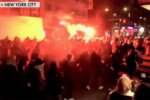Thousands participate in Civil War re-enactments every year. And as they restage the battles of Gettysburg, Antietam and Olustee, Christians are there to preach the timeless message of Jesus.
As the Confederate line moves forward to sweep the crumbling Union ranks from the field and win the Battle of Olustee for the 27th time, Chaplain Roger Niedrich kneels over the fallen Southern fighter to read Scripture and pray.
In a few minutes the casualty will, along with those around him sprawled on the north Florida terrain, spring up in full health, ready to fight another day. But for the time being, amid the swirl and smoke and screams of a recreated Civil War battle, Niedrich has a captive audience among the bodies littering the ground.
“I say things like: ‘I didn’t see you in church today; that’s probably why you are in the shape you are now,'” he laughs back in camp. “They tell me they will come to the next service. Sometimes God gives me a Scripture for them, and I will minister to them. Some of my best ministry is on the battlefield.”
An associate Assemblies of God pastor and cabinetmaker during the week, Niedrich on many weekends twins his zeal for evangelism and love for history to step back in time and reach out to members of the Civil War re-enacting community.
Across the country as many as 40,000-plus are believed to be involved in reliving the days when brother fought brother. Several thousand gathered in Pennsylvania in July to commemorate the Battle of Gettysburg, the war’s pivotal and best-known engagement–many enthusiastically reminiscing their participation in the 135th anniversary event in 1998.
Drawing an estimated 20,000 combatants, it was the biggest single
re-enactment to date, though almost as many are expected to assemble near Sharpsburg, Maryland, in September to mark the 140th anniversary of one of the bloodiest clashes of the war, Antietam.
But there are few weekends when the blues and grays can’t be found on duty somewhere. According to Bill Holschuh, editor of the Camp Chase Gazette–the re-enactors’ Bible–there are some 300-plus events a year, from large-scale recreations of conflict on the original field to living-history gatherings of just a handful. Civil War-interest publications feature advertisements for events that are promoted like a cross between a rock concert and a pilgrimage.
Add to the fighting men’s number the wives and children who take part in civilian re-enactments, and the thousands more spectators who turn out to watch passages of America’s most painful chapter repeat themselves, and there is an unlikely but significant mission field for Niedrich and others like him.
The re-enactors come from all walks of life–doctors and day laborers, professors and postal workers. Many trace their family lines back to those who served. All share a deep love for history and a respect for the hardships endured by men who fought and died in appalling numbers for what they believed in.
“It makes you appreciate how ordinary people did extraordinary things when their whole world was falling apart,” says Michael McCurdy, from Lilburn, Georgia. “For a couple of days you get the chance to get that much closer to what it was like–the smells, the sights. It’s a great way to learn history.”
For some it’s a fascination that borders on obsession. For hard-core re-enactors, attention to historical detail–down to the right kind of thread that would have been used for stitching–is just the start.
When they take part in historically authentic “immersion” weekends, they will check one another to see that no modern-day items slip through to spoil the time warp. Such forensic faithfulness doesn’t come cheap–uniform and arms can cost more than $2,000.
Sometimes they take on the identities of actual veterans, following historical events to the letter. “You can lose an awareness of the 21st century,” says Hal Merritt, a 24-year re-enactment veteran. Returning to the present day “makes you appreciate your life more,” he observes.
In the heat of recreated battle, passions can rise. Blood does spill occasionally, though it’s all forgiven fairly quickly.
Many talk about an almost mystical moment when everything comes together, and for a time they are no longer merely trying to replicate the past but somehow experiencing it as their own historic present. Some have dubbed the rush as “The Civil Wargasm.”
They speak of occasionally sensing the presence of those who died, as they tread the same ground. In tourist centers such as Gettysburg, Civil War “ghost tours” are big business, with guides telling–sometimes tall–tales of battleground apparitions. Not long ago, a psychic toured the re-enacting circuit offering to guide people into their past Civil War lives.
Yet at the same time, there is an openness to God. Niedrich finds that people who would not think of going to church in 2002 will attend his open-air camp services on Sunday mornings because it makes their re-enactment more authentic. Religion simply was a more accepted part of everyday life back in the 1860s.
They may go for a history lesson, but they get an altar call. At Olustee, at the end of a sermon in which Niedrich refers to his former alcoholism and drug addiction, he rejoices as four re-enactors step forward to respond to his invitation to pray to receive Christ.
Out on the battlefield–which in 1864 saw one of the war’s proportionally most costly fights as the Confederates defended their vital supply routes–he walks behind the Southern lines reading Scripture aloud, then praying over the fallen.
“The spectators think I am saying the last rites!” he says. Some of the wounded try to crawl away when they see him coming, he laughs. “They are more scared of me than the Yankees!”
During the rest of the weekend Niedrich and his wife, Laura–also in period dress–offer a listening ear and words of comfort or prayer to re-enactors who want to talk about their 21st century burdens. They also pass out reproduction Civil War tracts to the visitors.
He has performed weddings, marriage-vow renewals and baby dedications. One time the Deltona, Florida-based minister was even asked to say a few words as members of a unit gathered to remember a late colleague and, at the man’s request, watch his ashes being blasted across the battlefield from
a cannon.
“I have such a burden for these guys,” says the 45-year-old with a period-style beard and moustache. “I love them so much. I’d do anything for them.” A re-enactor for 20 years, he put down his gun and picked up a Bible instead some 10 years ago after recommitting his life following years of hard living.
Among those Niedrich’s Battle Line Ministries has touched is Mike Besser, a re-enactor for almost two decades. When they first met, Niedrich was “the furthest thing from a preacher,” he recalls. But when Besser attended a camp service after Niedrich’s renewal of faith, he was “captivated” by the preaching.
“He makes church fun and presents God in a way that you just can’t deny Him,” he says.
Like Niedrich, Joey Young–whose Old Paths Re-Enactors’ Missions is based in Athens, Georgia–not only conducts services but also follows the troops onto the battlefield. Going to the casualties, he says he will “pray for them, tuck a tract in their pocket.” Sometimes he asks, “If it was a real bullet between their eyes, would they know where they would spend eternity?”
Russell Cayler serves as a chaplain among the Union troops in California, which, despite the state’s distance from the Civil War theater, boasts a sizeable re-enacting community. A retired military helicopter pilot, he says his clerical role is “an opportunity to bring the Lord to people that often do not get it in the civilian world.”
Christian re-enactors can find themselves in a war zone in more ways than one.
“It can be a hostile environment, not necessarily in terms of, ‘We hate Christians,’ but the whole mind-set–the alcohol, the pervasive bad language. It’s just very secular,” observes Stuart Zaharek of Cedarville, Ohio.
Several years ago he formed the Christian Re-Enactors Network to both link believers for encouragement and support–some 300 are currently signed up–and provide a record of the importance of faith during the conflict, which Zaharek and other Christians say has been largely ignored by historians.
Phillip Surrey, a 20-year-old business student from Collinsville, Illinois, who has marched with Southern units since he was a young teen, launched a Web forum for Christian re-enactors earlier this year. His involvement in re-enacting has given him “a stronger desire to witness to people,” he says.
“There’s a lot of opportunities out there,” he notes. “The fact they are there to show respect for their forefathers shows they have a conscience, some kind of moral values.”
Much of the “ammunition” Christians in the re-enacting world use has been supplied by Alan Farley, who began pioneering Civil War re-enacting ministry almost 20 years ago. His Re-Enactor’s Mission for Jesus Christ has reproduced scores of tracts that were passed to both Northern and Southern soldiers.
Titles such as The Brand Plucked From Fire, Everlasting Punishment and Marks of Religious Declension point to their frequent hellfire-and-damnation-era message and their dated language. But Farley says that as well as being prized as souvenirs, they continue to touch people’s hearts to this day.
“They were written in a time of revival, and you can still sense the revival in the authors’ hearts,” he comments. “The Word is just as powerful, the Bible is just as alive today, and they speak. When you read them you find they are far more in-depth than anything that is handed out today–our minds are so ruined by TV and radio that we don’t have the concentration level we had in the past.”
Traveling more than 30,000 miles per year to events from his home in Appomatox County, Virginia–not far from the site of Lee’s surrender to Grant, which signaled the end of the war–Farley has recorded more than 1,200 decisions for Christ through his ministry.
He has encountered a mixed response from churches, some of which want to keep the Civil War at arm’s length because of the slavery issue. But at least one church uses re-enacting to draw people in. Averyville Baptist Church in East Peoria, Illinois, stages an annual battle over Memorial Day weekend, when the two sides clash on the church’s property.
Visitors get “lunch, a battle and a good hellfire-and-brimstone sermon” says church member Mike Scholl, who traces a chaplain in the Stonewall Brigade in his family tree and helps organize the event. “It’s all a thing to get more people to come out to hear the gospel.”
Out on the battlefield it may be “big boys with their toys,” as Niedrich puts it, but back in the camp there is room for the women. The real hard-core types who look down on participants with coolers also frown upon the “civilian camps” that allow for period-dress families at events. They point out that the only women who got close to the armies were the kind of camp followers that saw Gen. Joseph Hooker’s surname become another word for a prostitute.
But Margaret Gilbert sees her presence as continuing the ministry of her late husband, Robert, who was ordained to serve as a priest to the re-enacting community. From her Minneapolis home she travels to about 20 events a year, helping chaplains with their services. Formerly reserved about her faith, she says, “Now I can’t seem to stop [talking].”
She serves with the United States Christian Commission, founded during the war to minister to the Union troops and reactivated as a ministry that now supplies chaplains for re-enacting units. The National Civil War Association, which organizes events in California, has the Christian Committee that provides chaplains. It spells out that anyone wanting to take part in period ministry “is to do so as a matter of faith and religious belief, and not as merely a role to be played.”
Niedrich was a reluctant recruit to the ministry when first asked by an officer to lead a service; he enjoyed being in the ranks too much. He prayed about it and told God he didn’t want to preach.
“He said, ‘I didn’t want to hang on a cross, either,'” Niedrich recalls, and adds: “I never looked back.”
He says the first time he stepped out as a chaplain, he felt like someone who had just quit smoking for the first time: “I didn’t know what to do with my hands without my rifle. I felt so out of place.”
Now he grasps a Bible confidently, though he confesses to still feeling ready to throw up before he has to preach. “But when the Holy Spirit takes over, you don’t think about it anymore.”
For the 250 soldiers, civilians and spectators gathered outside his chaplain’s tent before the 26th annual Olustee re-enactment, Niedrich mixes personal testimony, impish humor and a heartfelt appeal for them to bring their problems to Jesus.
“A lot of people want to escape the reality of their 2002 problems and what better way than to send yourself back 140 years?” he reflects. “The only problem with that is that you are back there for 48 hours, but then you have to go on and come back to the real world, and the problems are still there.
“When people get saved [at his services] they are not doing it because they are thinking they are re-enacting something that happened in the past, but because they want answers to the questions they have back here in 2002.”
Healing Civil War Wounds
Some African Americans are helping re-enact the Civil War, including a minister who says the country’s racist past should not be ignored.
It may be one of the few things not historically authentic, but Clifford Pierce does a lot of hugging at Civil War re-enactments. “I just like to spread the joy of the Lord as I travel through the camps,” beams the National Parks Service maintenance worker.
The 51-year-old is one of a small but growing number of African Americans helping recreate the dark days of the 1861-1865 conflict. At Olustee, Florida, in February there is a woman portraying Harriet Tubman and at least one man in Confederate gray, recalling the blacks who fought for the South.
Pierce is here to represent Samuel Harrison, the real-life chaplain of the 54th Massachusetts, the first trained, black Union regiment to see action, whose bravery at Fort Wagner in Charleston, South Carolina, was portrayed in the Oscar-winning movie Glory.
At Olustee, the 54th ran to the battlefield, arriving just in time to prevent the collapse of the Northern flank. It’s said that when a train loaded with wounded broke down the following day, men of the 54th tied ropes to it and hauled it to its destination.
Pierce, who is an ordained preacher, isn’t here just to see history refought, though. He is campaigning for the future, too.
“I believe that you need to know where you have been in order to know where you are going,” he observes. “You need to understand the Confederate and Union history in the right perspective.”
A member of Paxon Revival Center in Jacksonville, Florida, Pierce visits schools in his uniform for living-history presentations, when he takes the opportunity to discuss division and reconciliation.
“God is still working on the plan,” he says. “We have to live together despite the ugly heritage that we have. Then God can work out the differences so that there will be joy in the morning.”
Despite the presence of acres of Confederate flags, Pierce says he has seen little racism in the re-enacting world. “Most of us are like family. The Confederates and Union will travel [to events] together.”
Pierce has even married four Confederate couples. “That was different,” he smiles.
David Riker, a history teacher who serves as a Confederate senior medical officer admits that, as in any cross section of society, there are some racists “but very few, because the community doesn’t like that. We don’t want to be labeled from a bunch of people who have abused our flag, namely the Ku Klux Klan, skinheads.”
Even Union sympathizers support the flying of the Stars and Bars. “It was one of the flags that flew over the state, so from an historical standpoint I don’t think it’s racist,” says Jeff Webb, an architect with the 115th New York State Volunteers. “But if you have guys flying it from their pickup trucks, it’s a little bit different.”
Southern re-enactors are quick to insist to visitors that the war was more about states’ rights of self-government than it was about slavery. The sensitive issue once gave longtime re-enactors’ chaplain Alan Farley the chance to minister to a spectator. The black woman visiting his tent wanted to know if he believed in slavery.
“I said, ‘I do believe in slavery,'” he remembers with a slight smile. “‘Every person is enslaved to their own sin until they are set free by the blood of Jesus.’ We sat down and had quite a nice conversation after that.”
Pierce, one of the few unarmed re-enactors around (“I carry the biggest weapon of all–the Word of God”), says the lessons of the Civil War offered by re-enactors need to be heard even more since 9/11. “We have to have our country as one, regardless of the problems. You can have differences, but your country can’t divide.”
The Civil War’s Best-Kept Secret: Confederate Revival?
Most people don’t know that revivals swept through the camps of Southern armies during the War Between the States.
The sutlers’ row to be found at many re-enactments is like a sort of “Civil Wal-Mart,” a one-stop collection of traders selling everything from uniforms and weapons to books addressing military minutiae such as bayonet drills and latrine digging.
But one historical aspect largely overlooked both at re-enactments and in aca-
demia is the significance of faith during the conflict. That large-scale revivals swept through the Southern camps is still the war’s “best-kept secret,” according to Lloyd Sprinkle, who has spent years trying to redress the imbalance.
The pastor of Park View Baptist Church in Harrisonburg, Virginia, estimates that as many as 100,000 Confederate soldiers may have given their lives to Christ through the efforts of chaplains, missionaries and colporteurs who passed out evangelistic tracts.
Some 200 million pages of gospel literature are estimated to have been distributed among Southern troops–an indication of the seriousness with which the message was viewed in a time when paper was in short supply.
Sprinkle stumbled across a copy of Christ in the Camp, by J. Williams Jones, a chaplain in the Army of Northern Virginia, in 1968. The 624-page account, published in 1887, recalled the passion stirred by the gospel–how men had stood barefoot in the snow to listen to sermons, and ministers preached three times a day to meet the demand for their message.
The book recorded how a contemporary newspaper reported: “The bivouac of the soldier never witnessed such nights of glory and days of splendor. The Pentecostal fire lights the camp, and the hosts of armed men sleep beneath the wings of angels rejoicing over many sinners that have repented.”
Sprinkle says: “I had no idea. I had been studying revivals all my life, and here was one that was totally overlooked.” He started a business to reproduce Jones’ book and has sold more than 20,000 copies in the United States and overseas. He has also republished 20-plus other Civil War titles, including The Great Revival in the Southern Armies, in which former chaplain William W. Bennett wrote in 1876 of a “glorious work of grace which is the great moral phenomenon of the present age.”
Researching the spiritual dimension of the war has “encouraged me with respect to revival, which we stand in such terrible need of in our day,” Sprinkle says. “If God can work in the midst of the devastation of that, and He did, why should we think that He cannot and would not do that even for us?”
Chaplains and missionaries were busy in the Union camps, too, but though there were localized revivals, the move of God was not nearly as strong as among the Confederate troops.
In his journals, edited and published in 2001 as The Preacher’s Tale, Union chaplain Francis Springer wrote of his frustration at the officers who “desecrate the Sabbath” by organizing pay distributions and parades on Sundays. Springer held services, led Bible studies and prayed with Union deserters and Confederate bushwhackers before they were executed.
Springer recalled meeting with one fatally wounded Northerner, quoting Scripture. “I directed the young man, vigorous in the springtime of life, to the Savior of men.”
Andy Butcher is senior writer with Charisma and editor of Charisma News Service, an e-mail news bulletin published weekdays.






Leave a Comment
You must be logged in to post a comment.